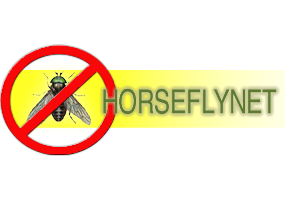-
The Horn Fly
Where do all of these nasty flies come from? These little guys are half the size of the stable fly which
blood suck their diet from the back and belly of the horses. They will remain on their host day and night. But the most important fact is that they are breeding in freshly deposited manure during hot and humid weather of late summer. At this time the Horn Fly life cycle is 10 days.
Another important fact to remember about these flies is that they are most often found on horses who are pastured in regions where cattle are raised. The regular manuring of cattle gives the horn fly its continuous supply of breeding material. The pupae overwinter under cow patties. Cattle suffer these bests as well and show up as blankets of flies on their backs.
Controlling Horn Flies is difficult for pastured horses. If possible move horses away from cattle. It helps to keep paddocks and stalls free of manure and cover the stock piles to reduce breeding of the Horn Fly.
This is not the fly that bothers the horses face therefore face masks are a nuisance, putting them on, keeping them on. Dragging fields to break up the manure pile will help and using a small buckets to pick out stalls quickly will help. But, manure stockpiles should be covered, mulched and taken away. Horse Fly Nets on run-in-sheds and fly spray will ease horses while they are in the field. Horses who live out with little attention can be so bothered by the swarms of biting Horn Flies that they will loose weight and condition.
Horn Flies
Call Us at (910) 725-2115 or Email Us at info@horseflynet.com
Horse Fly Net
This see-through breathable screen will last for years. It is made of polyester vinyl coated and heat sealed on the edges with brass grommets about every foot. It has no chemicals added. Our HorseFlyNets only cost approximately $2.00 a square foot for smaller sizes and less for larger. Our product is woven and manufactured in the USA.
HorseFlyNet®
Southern Pines, NC
(910) 725-2115
info@horseflynet.com

